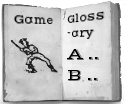Single-Wicket Cricket
| Game | Single-Wicket Cricket |
|---|---|
| Game Family | Baseball |
| Location | |
| Regions | US, Britain |
| Eras | 1700s, 1800s, Post-1900, Predecessor |
| Invented | No |
| Tags | |
| Description | Single-wicket cricket uses teams smaller than the usual 11-player teams. All bowling is to a single wicket. There is, in effect, a foul ground behind the wicket, so unlike full-team cricket, only balls hit forward are deemed to be in play. As late at 1969 there were annual single-wicket championships at Lord’s in London. In the very early years, most cricket is believed to use a single wicket, and each references to cricket in the US usually reported very small numbers of players. Early cricket rules called for single-wicket play when team sizes were five or fewer. This game was nearly as popular as cricket in England through the 1840s, when it lost favor (see Steel). Frederick Duke of York (1763-1827; son of George III) played SWC with his brothers when he was young. The Sunbury Gazette, Sept. 3, 1859 reprints an essay on cricket from the North American, and labels single-wicket a predecessor game to cricket. H. Rowell, "The Laws of Cricket for Single and Double Wicket" (Toronto, 1857) p. 17 says single wicket is for teams of 5 or less, and specifies "bounds" placed 22 yards apart in a line from the off and leg stump (which appears to give a 180 degree fair territory). The ball had to be tossed, not thrown, underhand. "THE LAWS OF CRICKET LAWS FOR SINGLE WICKET When there shall be less than five players on a Side, Bounds shall be placed twenty-two yards each in a Line from the Off, and Leg Stump. The Ball must be hit before the Bounds to entitle the Striker to a Run; which Run cannot be obtained unless he touch the Bowling Stump (or Crease in a line with it) with his Bat, or some Part of his Person; or go beyond them; returning to the Popping Crease as at double wicket according to the 22nd Law. When the Striker shall hit the Ball, one of his Feet must be on the Ground, and behind the Popping Crease; otherwise the Umpire shall call “No Hit”. When there shall be less than five Players on a Side neither Byes, nor Overthrows shall be allowed; nor shall the Striker be caught out behind the Wicket, nor stumped out. The Field’s Man must return to Ball so that it shall cross the Play between the Wicket and the Bowling Stump, or between the Bowling Stump, and the Bounds; the Striker may run till the Ball shall be so returned. After the Striker shall have made one Run, if he start again he must touch the Bowling Stump, and turn before the Ball shall cross the Play to entitle him to another. The Striker shall be entitled to three Runs for lost Ball, and the same number for Ball stopped with Hat; with Reference to the 29th, and 34th Law at double wicket. When there shall be more than four Players on a side there shall be no Bounds. All Hits, Byes, and Overthrows shall then be allowed. The Bowler is subject to the same Laws as at double Wicket. Not more than one Minute shall be allowed between each Ball." |
| Sources | Thorne, Baseball in the Garden of Eden, p. 79. Rowell, p. 17; wikipedia; New York Clipper, May 24, 1856: https://crickethistory.website/single_wicket/single_wicket_checklist.html Origins Committee Newsletter, October, 2022. |
| Source Image | File:072243 Laws of Cricket with Provisions for Bets.pdf |
| Comment | The single-wicket game was often played in the U.S. See Chronologies 1845.23 and 1864.46. See also New York Herald, Sept. 12, 1844; Oct. 25, Nov. 4, 1845; May 16, 1846; Oct. 5, 1847; New York Times, May 9, 1855; Sunbury Gazette, July 30, 1859; Milwaukee Daily Free Democrat, Oct. 6, 1852. These games involved anywhere from 1 to 8 players a side. For other pre-1840 American mentions of the rules of single wicket, see Parley's Magazine (1838); The Boys Own Book (1834); Gentleman's Magazine vol. 5 (1839); Hoyle's Rules (1838). See also "The American Boy's Book of Sports and Games" (1864), pp. 77-79; A. G. Steel et al., "Cricket" (1888) chapter 14. https://crickethistory.website/single_wicket/single_wicket_checklist.html lists 17 SWC games in the US prior to 1850, 37 more 1850-60, 15 more 1861-70. The same website lists 560 SWC matches (almost all in the UK) in the 1830s, and 144 in the 1820s. The majority of the games involved 1-2 players a side. The earliest SWC match recorded is in England in 1712. Edit with form to add a comment |
| Query | Edit with form to add a query |
| Has Supplemental Text |
Comments
<comments voting="Plus" />
